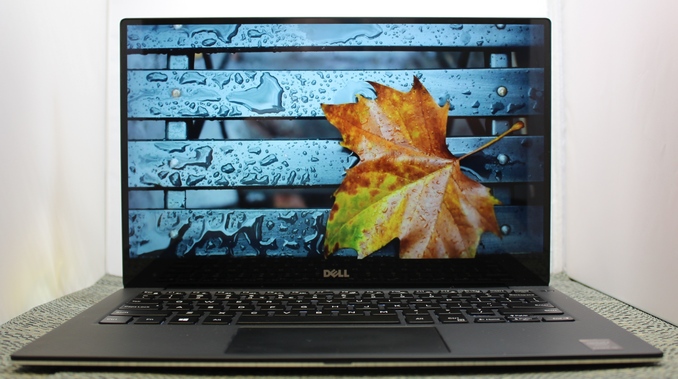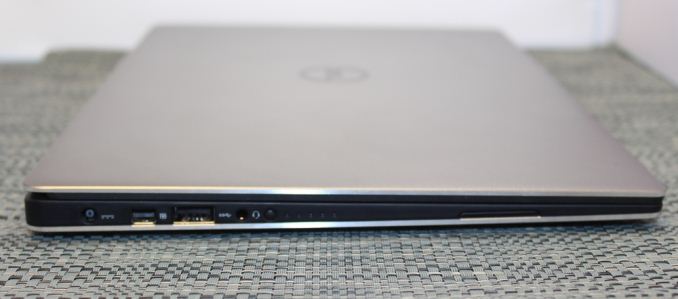Dell XPS 13 Review
by Brett Howse on February 19, 2015 9:00 AM EST- Posted in
- Laptops
- Dell
- Ultrabook
- Broadwell-U
- XPS 13

Dell launched the 2015 version of their XPS 13 at CES in January, and it made a big impression because of something that was very small. The first thing you see when you look at the XPS 13 is how small the bezels are around the display. At 5.2 mm, they are easily the thinnest display bezels on any laptop made today. Dell claims the XPS 13 is a 13 inch display in the chassis of an 11 inch notebook, and while they have made that claim before, for 2015, it would be hard to argue with them. But the XPS 13 is more than just a display, and Dell has outfitted it with some very modern hardware to give us our first look at an Ultrabook based on the just launched Intel 5th Generation processors, Broadwell-U.
At CES, Dell also told me that the new XPS 13 would have great battery life, with the company claiming that it would get up to fifteen hours. That claim seems hard to believe, with our battery life test topped at just a hair under ten hours by the current leader, the MacBook Air 13. However, this will be our first look at a laptop running on the new 14 nm process from Intel, so we can get a chance to see just how power efficient the new processors are.
Dell is offering quite an arrangement of options as well, allowing the new XPS 13 to fit into a lot more budgets than some of the other premium notebooks around. The base model comes with the Intel Core i3-5010U processor, but if you need more speed you can upgrade to the i5-5200U or i7-5500U. All of the storage options are solid state drives, which is great to see. The base is 128GB, and optional upgrades are to 256GB or 512GB. Memory choices are dual-channel 4GB DDR3L-RS-1600, or a dual-channel 8GB option.
We received two models for testing, with the first being a Core i5-5200U with the 1920x1080 non-touch display, 4GB of memory, and a 128GB SSD, which lists for $900. The second model is the Core i5-5200U, with 2x4GB of memory, a 256GB SSD, and the 3200x1800 touch display. This model lists at $1400.
Update: Originally I had listed the 4 GB model as single channel, but it is actually 2 x 2 GB for dual channel. Sorry for the mistake.
| Dell XPS 13 9343 Specifications | |
| Processor | Intel Core i3-5010U (Dual-core + HT 2.1GHz 3MB L3 14nm 15W TDP) Intel Core i5-5200U - model tested (Dual-core + HT 2.2-2.7GHz 3MB L3 14nm 15W TDP) Intel Core i7-5500U (Dual-core + HT 2.4-3.0GHz, 4MB L3, 14nm, 15W TDP) |
| Chipset | Broadwell-ULT |
| Memory | 2 x 2GB or 2 x 4GB DDR3L-RS-1600 (Dual Channel 8GB Max) |
| Graphics | Intel HD 5500 (23 EUs at 300-900MHz on Core i3) (24 EUs at 300-900MHz on Core i5) (24 EUs at 300-950MHz on Core i7) |
| Display | 13.3" Anti-Glare IPS 16:9 FHD (1920x1080) (Sharp 1420 Panel) 13.3" Glossy IPS 16:9 QHD+ (3200x1800) IGZO2 (Sharp 1421 Panel with Corning Gorilla Glass NBT and Touchscreen) |
| Storage | 128GB/256GB/512GB SSD (Samsung PM851 M.2 2280) |
| Optical Drive | N/A |
| Networking | Dell Wireless 1560 plus Bluetooth 4.0 - model tested (2x2:2 802.11ac 867Mbps capable Broadcom) Intel Dual Band Wireless-AC 7265 plus Bluetooth 4.0 (2x2:2 802.11ac 867Mbps capable) Intel Dual Band Wireless-N 7265 plus Bluetooth 4.0 (2x2:2 802.11n 300Mbps capable) |
| Audio | Realtek HD Stereo Speakers professionally tuned with Waves MaxxAudio Pro 1w x 2 Headset jack |
| Battery/Power | 52Wh non-removable 45W Max AC Adapter |
| Front Side | Charge Light |
| Left Side | Headset Jack Battery Meter 1 x USB 3.0 with PowerShare 1 x mini DisplayPort Speaker AC Power Connection |
| Right Side | Noble Lock Slot 1 x USB 3.0 with PowerShare SD Card Slot Speaker |
| Back Side | N/A |
| Operating System | Windows 8.1 64-bit |
| Dimensions | 11.98" x 7.88" x 0.33-0.6" (WxDxH) (304mm x 200mm x 9-15mm) |
| Weight | 2.6 lbs (1.18kg) Non-Touch 2.8 lbs (1.27kg) Touch |
| Extras | 720p HD Webcam Backlit Keyboard |
| Colors | Silver |
| Pricing | $800 (i3, 4GB, 128GB, FHD) $900 (i5, 4GB, 128GB, FHD) - model tested $1000 (i5, 8GB, 128GB, FHD) $1300 (i5, 8GB 128GB, QHD+) $1400 (i5, 8GB, 256GB, QHD+) - model tested $1600 (i7, 8GB, 256GB, QHD+) $1900 (i7, 8GB, 512GB, QHD+) |
The display has some choices as well. The base model comes with a 13.3 inch 1920x1080 IPS display, with a matte finish, and no touch capabilities. This is still a respectable 165 pixels per inch, and is a good option to keep the costs down. The upgraded display is quite the upgrade. Dell has worked with Sharp to outfit the XPS 13 with an optional 3200x1800 resolution IGZO panel, which features Corning Gorilla Glass NBT over the top, along with ten-point multitouch. This works out to 272 pixels per inch, and the IGZO panel is a full RGB stripe.
There are a couple of other options as well, such as a range of wireless adapters, with the Dell 1560 outfitted on the review laptops that we received. This is a Broadcom wireless adapter, with 802.11ac support. Some of the options, like the 512GB drive, are only available with the top CPU and upgraded display. Dell does offer some degree of flexibility when ordering, but not all options are available for all devices.
Dell has crafted a fine looking laptop, with some new parts from Intel and Sharp paving the way. On paper this is a great start, so let's get into the finer details.











201 Comments
View All Comments
Wineohe - Thursday, February 19, 2015 - link
I see reviews of laptops with decent IPS displays but then when I actually try to purchase them they don't seem to exist. They seem to offer them for a time, and then they don't. I used a small XPS and now a Lenovo X220, both with IPS for my photography work(amateur), but I've been starting to look for a replacement. The X220 is really toooo small for my aging eyes. This looks perfect and frankly I don't think the price is that bad. My last two were in the 2k range. However the inability to calibrate is a non starter with me. They have to sort that out.Shadowmaster625 - Thursday, February 19, 2015 - link
Can you add DOTA2 battery life. I'm guessing even this notebook would struggle to deliver 3 hours of DOTA/LOL but it would be nice to know for sure.Jeff7181 - Thursday, February 19, 2015 - link
After my experience with the XPS12 and Dell's support, I wouldn't touch this thing with a 10 foot pole. My XPS12 is just plain broken and Dell won't do anything for me except keep sending me a box to ship it to their depot, where they do nothing but reinstall the OS, verify it boots and send it back. Extremely disappointed.peterfares - Thursday, February 19, 2015 - link
If you've had it serviced multiple times and are still in warranty insist on having the unit replaced. I had a first gen XPS 12 that Dell replaced with a 2nd gen XPS 12 last year (and got upgraded from a 256GB SSD to 512GB)VengenceIsMineX - Thursday, February 19, 2015 - link
I'm very curious about the auto brightness issue. That is a Windows control in the detailed power settings not something that is usually manufacturer specific, did turning Display>Enable Adaptive Brightness off not work?Also, just for clarity, was this a version straight from Dell with their usual bloat or a clean software image like what Microsoft sells in their stores? Seeing some wildly varying reviews on battery life, for example the Verge ragged the battery as being 6 hours in normal usage which is obviously not what you are seeing and I'm curious about possible reasons.
Drumsticks - Thursday, February 19, 2015 - link
For starters the Verge places the brightness at like 70% during their battery tests, which is going to seriously penalize this display. Basically, their reviews aren't exactly scientific. (The reviewer even mentioned how like 30% brightness was enough for him).Ryan Smith - Thursday, February 19, 2015 - link
"did turning Display>Enable Adaptive Brightness off not work?"Correct. It is not possible to turn off adaptive brightness at the moment.
Brett Howse - Thursday, February 19, 2015 - link
I'm not sure what other sites do for testing, but we try to be as consistent as possible. The laptops are put in power saving mode, the display is put at as close to 200 nits as possible, and we use IE to test for battery life. All of our tests are repeated multiple times. All I can say is that I checked this a couple of times, and with the asterisk that Dell has enabled adaptive brightness with no way to disable it, the results were consistent across the runs.VengenceIsMineX - Thursday, February 19, 2015 - link
If you really wanted a big SSD on the FHD model, it is pretty cheap to just buy it with the 128 gb hd and install your own 512GB even with it being m2. 512GB SATA 3 Transcend on Amazon is now just over $200, PCIe at roughly twice that. Given OEM's tendency to gouge on storage (at least not as bad as Apple which is just outrageous) it's the better way to go and even with drive copying and screwdriver work it's a 30 minute operation.repoman27 - Thursday, February 19, 2015 - link
If you're comparing the prices of the cheapest SSDs you can find on Amazon or Newegg to CTO options from a major OEM, there's obviously going to be a difference. What makes Apple's pricing "gouging"? 256 GB SSD options generally run $200 extra compared to 128 GB, or $500 extra for 512 GB. Do you have a cheaper source for Samsung XP951 based PCIe 2.0 x4 SSDs using MLC NAND?